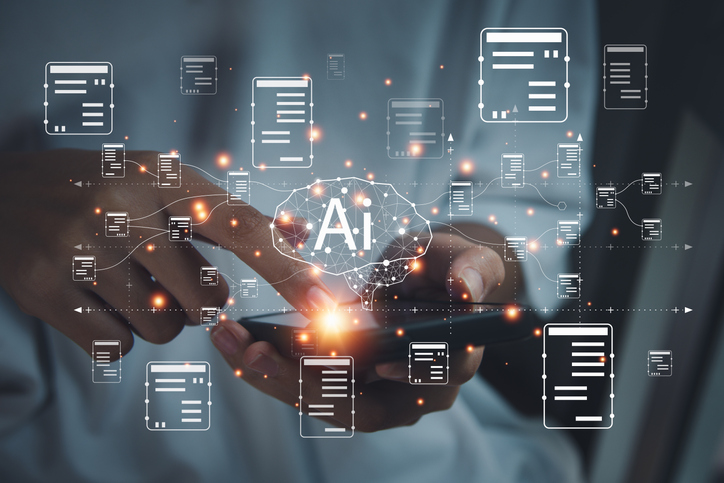Artificial Intelligence (AI) continues to be a driving force behind innovations that redefine how businesses operate. One of the most transformative advancements in AI is the rise of Generative AI, a subset of AI that focuses on creating new content, ideas, or predictions based on input data. While generative AI is often associated with creative fields like design, art, and content generation, its real strength lies in its ability to drive actionable insights that inform decision-making across industries.

In this blog post, we’ll explore the fundamentals of generative AI, its potential for business applications, and how companies can leverage it to transform raw data into insights that fuel strategic growth. We’ll also highlight how Syntes AI integrates generative AI within its platform to offer businesses advanced capabilities for predictive insights and smarter decisions.
Generative AI refers to systems that use algorithms to generate new data, whether it be text, images, videos, or even predictive models. Unlike traditional AI systems that are often confined to analyzing existing data and providing predefined outputs, generative AI has the ability to create something entirely new by learning from the data it has been trained on.
At its core, generative AI models can be broken down into two primary types:
Generative AI is not just about creation but also about synthesis—it pulls from vast data sets to produce predictions, recommendations, and new patterns that traditional analytics may miss.
While generative AI is often associated with creative fields—like producing realistic images, generating natural language, or designing virtual products—it has far broader applications in business. The power of generative AI lies in its ability to transform data into actionable insights.
For businesses, this means using generative AI to:
Generative AI can assist companies in not only understanding what has happened but also in predicting what will happen and suggesting what actions should be taken. The ability to generate new possibilities and scenarios based on past data allows businesses to gain a competitive edge in their industries.
In the realm of business intelligence, actionable insights refer to the conclusions drawn from data analysis that can directly influence decision-making and strategic planning. Generative AI excels at uncovering these insights in ways that traditional analytics might not, by:
Generative AI can analyze vast amounts of historical data to not only understand current patterns but also predict future trends. This predictive capability allows businesses to anticipate market changes, customer needs, and operational challenges before they occur. For instance, in industries like retail, generative AI can forecast demand and optimize inventory based on expected future conditions.
Generative AI enables businesses to model and simulate various business scenarios without needing to disrupt current operations. By generating different possible outcomes based on the data it has processed, generative AI can assist decision-makers in evaluating potential risks and rewards associated with different strategies. This ability to “test” multiple strategies at once can save time, reduce operational risk, and ensure more informed decision-making.
Generative AI helps businesses optimize their internal workflows by analyzing existing processes and proposing improvements. By examining employee productivity, resource allocation, or customer service patterns, it can generate optimized operational models that increase efficiency and reduce costs. For example, generative AI could recommend shifting certain processes to automation to free up human resources for higher-value tasks.
Customer experiences are increasingly driven by personalized interactions. Generative AI allows businesses to offer more personalized experiences by predicting individual customer preferences and behavior. By generating tailored recommendations or content for each user, businesses can enhance engagement, build loyalty, and increase conversion rates. For example, an e-commerce platform can use generative AI to predict what products a customer is likely to purchase and recommend those in real time.
A significant portion of data generated by businesses today is unstructured—emails, social media posts, customer reviews, etc. Generative AI excels at processing unstructured data and transforming it into valuable insights. By analyzing text, audio, or image data, generative AI can detect emerging trends, customer sentiments, and even identify areas for improvement that might otherwise go unnoticed.
One company that’s leading the charge in leveraging generative AI for actionable insights is Syntes AI. Syntes AI seamlessly integrates generative AI within its platform, allowing businesses to go beyond traditional analytics and unlock new growth opportunities by synthesizing complex data into actionable intelligence.
Here’s how Syntes AI’s platform helps businesses leverage generative AI:
Through Syntes AI’s platform, companies are empowered to make smarter, data-driven decisions with ease. Its user-friendly interface and customizable dashboards ensure that even non-technical users can leverage the power of generative AI to achieve their goals.
Generative AI is already transforming various industries by providing businesses with the ability to generate actionable insights from vast datasets. Let’s look at a few examples of how generative AI is being applied in the real world:
While generative AI holds immense potential, it’s important for businesses to approach implementation strategically. Here are a few best practices to keep in mind:
Generative AI is more than just a buzzword—it’s a transformative technology that allows businesses to generate new, actionable insights from their data. By predicting future trends, optimizing operations, and enhancing personalization, generative AI offers a wealth of possibilities for organizations looking to grow in an increasingly data-driven world.
With platforms like Syntes AI leading the charge, businesses have access to advanced generative AI tools that make these possibilities a reality. By harnessing the power of generative AI, companies can unlock new opportunities, drive smarter decision-making, and set themselves on a path to sustainable growth. Contact Syntes AI today to unlock the future of business growth today!